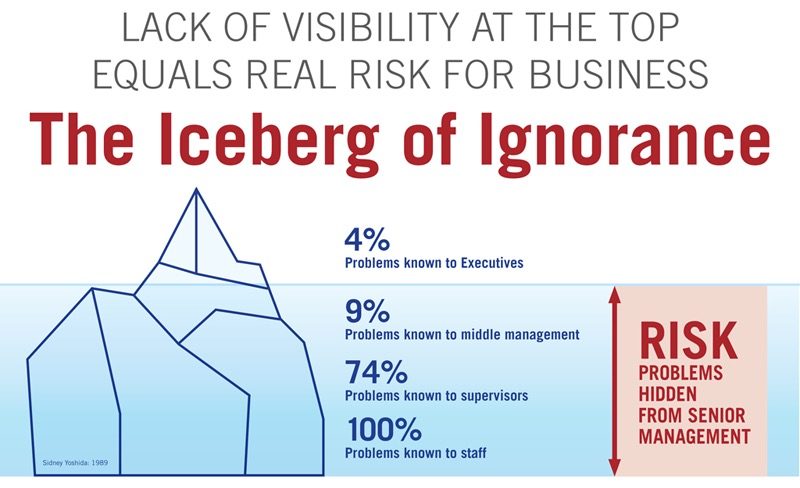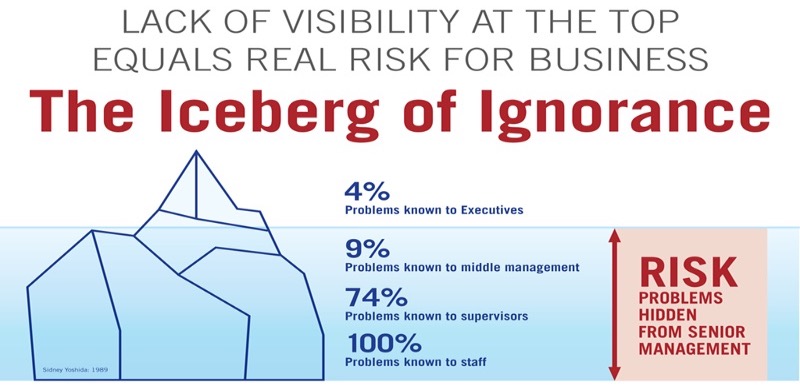Before we move further into this editorial series, I want to reiterate a comment made in Part One, yesterday, because I don’t want anyone to feel insulted by today’s discussion.
Ignorance is not the same thing as stupidity. I’m ‘ignorant’ if I haven’t yet been exposed to the necessary information. I’m ‘stupid’ if I’m unable to understand the information I receive or inept at making sensible use of the information.
When we look at the various contemporary illustrations found on the Internet of Sidney Yoshida’s ‘Iceberg of Ignorance’ data, from his 1989 study of Japanese corporations, we perceive that the top executives and middle managers interviewed by Mr. Yoshida were generally ignorant about production line quality control issues, while the production line workers were very aware of the problems.

But there are various types of ignorance that consultant Yoshida probably didn’t address in his study, “Quality Improvement and TQC Management at Calsonic in Japan and Overseas”. Mr. Yoshida was interested in Total Quality Control in selected Japanese firms. But “ignorance” is a huge topic that extends far beyond “corporate quality control.”
For example. Mr. Yoshida could have (but probably didn’t) assessed how much the top executives knew about American baseball teams, compared to what the workers on the production line knew. This data would have little bearing on the success of a corporation, but it would be data nevertheless and would expose a certain level of “ignorance.”
My point being, you can be ignorant about the task at hand, and you can be ignorant about the great big world outside, and the implications are hugely different. I don’t care if my brain surgeon knows who won the World Series; I care very much how much he knows about brain surgery.
Yesterday, I mentioned a couple of the topics that were discussed at the Southwestern Water Conservation District Annual Water Seminar on Friday. I was exposed to a great deal of new information during that day-long event, some of which I will be able to remember and perhaps make use of. But speaking frankly, much of the provided information went in one ear, and out the other.
Too much information, without sufficient time to process it and correlate it, might as well be no information at all. Information, to be useful, has to relate to stuff you already knew or to something you were hoping to learn about. Listening to, or reading, ‘raw information’ unrelated to your current interests and activities is typically a huge waste of time, in my humble opinion. And the more complex and unfamiliar the information, the longer we need to process it.
Which brings us to today’s topic.
The Pagosa Springs Town Council will be hosting a public hearing tonight, Tuesday November 5, at the Ross Aragon Community Center at 5pm. The subject of the public hearing is a resolution, Resolution 2019-18, which — if approved by the Council — would initiate the creation of an Urban Renewal Authority (URA), a new layer of government encompassing the entire Town limits. You can download the 28-page Council packet here.
The 28-page packet doesn’t come close to addressing the complexity of this issue.
Urban Renewal Authorities and similar governmental agencies are common all across the US, but they are, in a sense, ‘dinosaurs that somehow never went extinct’. The laws written to allow for these authorities date back to the 1950s when the federal government was doling out money to eliminate the slums that had appeared in America’s larger cities during the first half of the 20th century. The law governing urban renewal in Colorado was passed in 1958, and was initially used almost exclusively within the City of Denver.
By 1975, however, the federal money had dried up, so Colorado’s Urban Renewal Law was updated to allow cities and towns to use Tax Increment Financing (TIF) to fund ‘urban renewal’ schemes. TIF funding was invented in California as a form of corporate welfare that can make even a marginal development project profitable for the developer. Using a TIF, a municipality extracts property tax revenues from surrounding government entities to reimburse certain developer’s costs within the town limits. California has since outlawed its TIF-funded ‘redevelopment agencies.’
In the case of Pagosa Springs, the proposal to establish a TIF-funded URA has been brought forward by Texas-based developer David Dronet, of Dronet Development Group, and Jack Searle, owner of BWD Construction and also 27 vacant acres adjacent to the Springs Resort. As far as I can tell, Dronet Development Group has never overseen any development project, anywhere. The company is not even listed, currently, on David Dronet’s personal LinkedIn web page.
The central question facing the Town Council at tonight’s meeting — the possible creation of a new Urban Renewal Authority — is not directly related to David Dronet’s development plans. On the other hand, it’s directly related to David Dronet’s development plans.
The creation of an Authority would affect the entire Town limits, and would also potentially affect the tax revenues of every government agency in Archuleta County: the County, the Fire District, three water districts, the Medical Center, the Library District and most significantly the School District.
If you read the documents provided to the Town Council in their meeting packet, Resolution 2019-18 states:
NOW, THEREFORE, BE IT RESOLVED by the Town Council of the Town of Pagosa Springs, Colorado, that:
Section 1. The foregoing recitals are incorporated herein by reference.
Section 2. The Town Council finds, determines and declares that the following conditions exist in areas of the Town:
a. Predominance of defective or inadequate street layout;
b. Faulty lot layout in relation to size, adequacy, accessibility, or
usefulness;
c. Unsanitary or unsafe conditions;
d. Deterioration of site or other improvements;
e. Unusual topography or inadequate public improvements or utilities;
f. The existence of conditions that endanger life or property by fire or
other causes;
g. The existence of health, safety, or welfare factors requiring high
levels of municipal services or substantial physical underutilization
or vacancy of sites, buildings, or other improvements.
Developer David Dronet has asserted that all the above stated conditions exist on the 27 vacant acres owned by Jack Searle. No one has claimed that any of these conditions exist anywhere else in Pagosa Springs. So tonight’s URA decision appears to be directly related to David Dronet’s proposed development.
Does the Town Council have all the information they need to make a decision that could forever alter the tax funding of government entities in our community?
Does the Town Council have extensive knowledge about Mr. Dronet’s background?
Does the Town Council understand why numerous Colorado municipalities have outlawed TIF financing since 2010?
Does the Town Council know about the corruption that often accompanies URA projects, as time goes by?
Does the Town Council have expert knowledge about targeted economic development, in a town suffering from low wages and unaffordable housing for its workforce?
Will Mr. Dronet make a tidy profit flipping tax-enhanced property once a URA is in place — funded by local government agencies who had no say in the matter?
These are questions to which I have no answers. It’s my belief that the Town Council also cannot answer the above questions.
Can the Town Council acknowledge how ignorant they are, about some very important facts — how ignorant we all are, at this moment in time?

